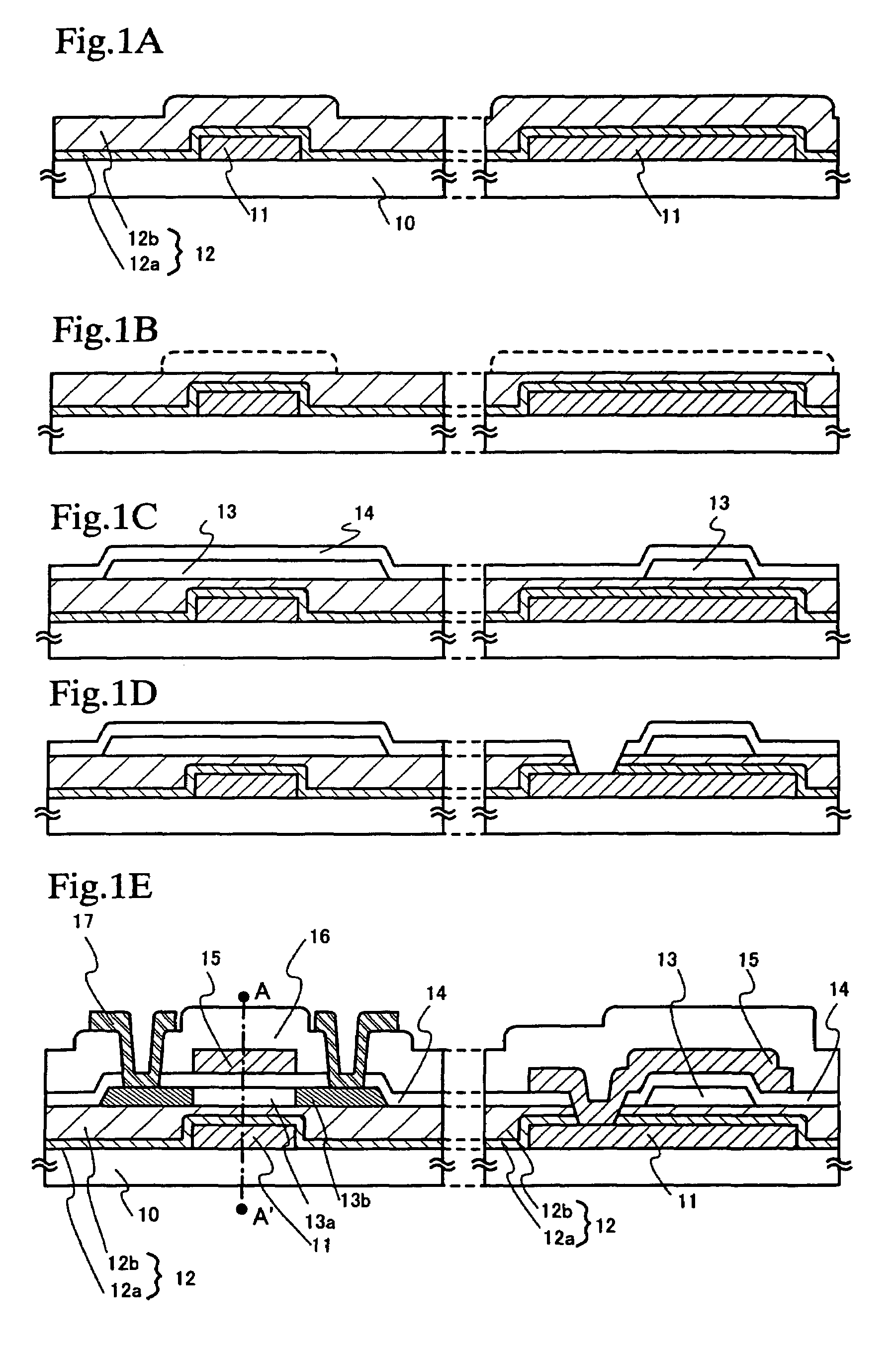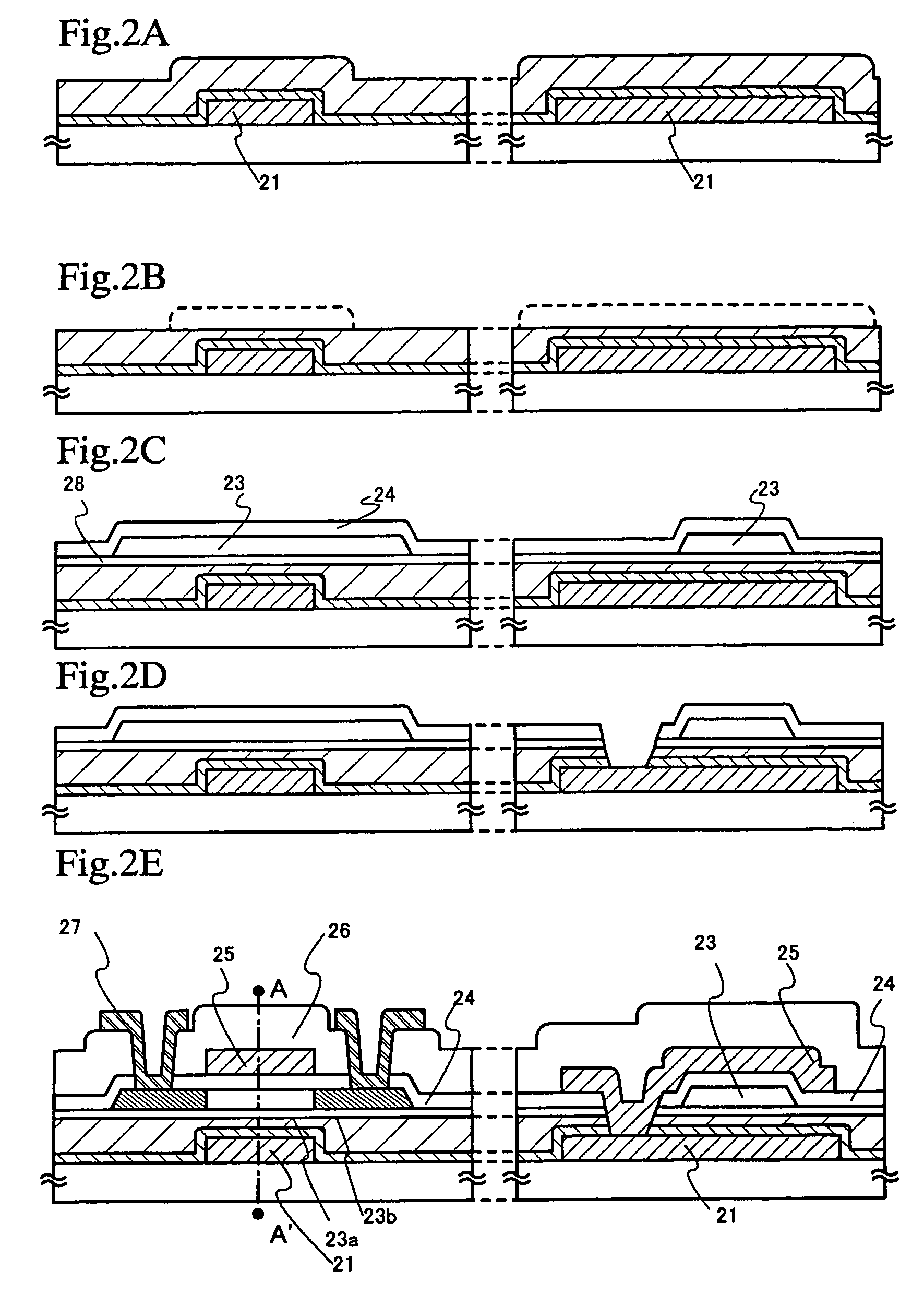Light emitting device and method of manufacturing a semiconductor device
a technology of light-emitting devices and semiconductor devices, which is applied in the direction of semiconductor devices, electrical equipment, transistors, etc., can solve the problems of increasing the probability of contact defects, low electric field effect mobility of tft using amorphous silicon, and inability to operate at the frequency required to process video signals
- Summary
- Abstract
- Description
- Claims
- Application Information
AI Technical Summary
Benefits of technology
Problems solved by technology
Method used
Image
Examples
embodiment mode 1
[0112]The following is a brief explanation on a typical procedure of manufacturing a TFT. The explanation is given with reference to FIGS. 1A to 1E.
[0113]In FIG. 1A, reference symbol 10 denotes a substrate which has an insulating surface, 11, a first electrode, and 12, a first insulating film.
[0114]First, a conductive film is formed on the substrate 10 and is patterned to form the first electrode 11 constituted of a metal or an alloy. Typically, the first electrode is formed from an alloy containing one or more kinds of elements selected from the group consisting of aluminum (Al), tungsten (W), molybdenum (Mo), tantalum (Ta), and titanium (Ti), or from an alloy containing silicon and one or more of the above elements. Alternatively, a laminate of several conductive films may be used for the first electrode. The first electrode 11 is 150 to 400 nm in thickness.
[0115]The first electrode 11 is a scanning line connected to a gate electrode that is formed later. The first electrode 11 ma...
embodiment mode 2
[0149]An example of manufacturing a TFT by a procedure different from the one in the above Embodiment Mode 1 is shown in FIGS. 2A to 2E.
[0150]FIG. 2A is identical with FIG. 1A. FIG. 2B is identical with FIG. 1B. This embodiment mode follows Embodiment Mode 1 until the state of FIG. 2B is reached.
[0151]After the state shown in FIG. 2B is reached, a second insulating film 28 is formed. An insulating film mainly containing silicon is used as the second insulating film 28. On the second insulating film 28, a semiconductor film 23 is formed following the procedure of Embodiment Mode 1 described above.
[0152]Next, the surface of the semiconductor film is washed with an etchant that contains fluoric acid to remove an oxide film or impurities. Then a third insulating film 24 mainly containing silicon is formed to serve as a gate insulating film. (FIG. 2C) Desirably, the surface washing and formation of third insulating film 24 are carried out continuously without exposing the substrate to th...
embodiment mode 3
[0158]An example of manufacturing a TFT by a procedure different from the one in the above Embodiment Mode 1 is shown in FIGS. 3A to 3E.
[0159]FIG. 3A is identical with FIG. 1A. FIG. 3B is identical with FIG. 1B. FIG. 3C is identical with FIG. 1C. This embodiment mode follows Embodiment Mode 1 until the state of FIG. 3C is reached.
[0160]After the state of FIG. 3C is reached, the surface of the second insulating film (gate insulating film) 34 is washed to form a second electrode 35 that serves as a gate electrode. Next, the semiconductor film is appropriately doped with an impurity element that gives a semiconductor the n type conductivity (such as P or As), here, phosphorus, to form impurity regions 33b. One of the impurity regions 33b serves as a source region and the other serves as a drain region. After doped with the impurity element, the semiconductor film is subjected to heat treatment, irradiation of intense light, or laser light irradiation in order to activate the impurity e...
PUM
 Login to View More
Login to View More Abstract
Description
Claims
Application Information
 Login to View More
Login to View More - R&D
- Intellectual Property
- Life Sciences
- Materials
- Tech Scout
- Unparalleled Data Quality
- Higher Quality Content
- 60% Fewer Hallucinations
Browse by: Latest US Patents, China's latest patents, Technical Efficacy Thesaurus, Application Domain, Technology Topic, Popular Technical Reports.
© 2025 PatSnap. All rights reserved.Legal|Privacy policy|Modern Slavery Act Transparency Statement|Sitemap|About US| Contact US: help@patsnap.com



